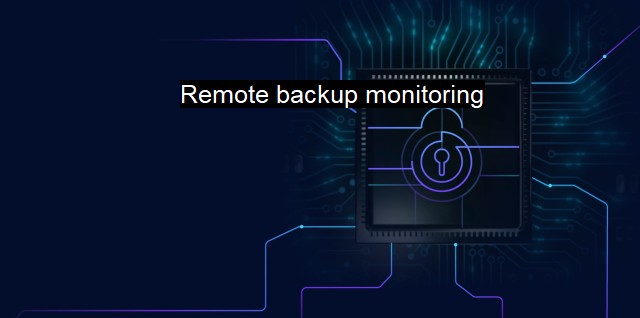What is Remote backup monitoring?
Protecting Your Data with Remote Backup Monitoring: Mitigating the Risk of Cybersecurity Breaches in the Age of Cloud Computing
Remote backup monitoring is a critical practice in cybersecurity and antivirus. It involves observing, managing, and ensuring the security of data that's stored remotely, typically in a cloud storage service or another off-premise server. This practice becomes necessary for businesses and individuals who handle sensitive data, especially in the modern age where data breaches and losses can cost billions of dollars.In the simplest terms, 'remote backup' refers to the process of saving data to an off-site server or cloud environment. This could mean replicating the data stored on a local system and transplanting it to a server that's located in a different geographic area. The objective is to preserve data in a secure mode that's immune to threats like hard drive failure, physical damage, theft, or local disasters.
'Monitoring' in this case, pertains to the continuous supervision of these remote backups. It's not sufficient to just copy data and store it elsewhere; it's equally crucial to constantly review the health and status of these backups, watch for any potential threats or failures, and make sure they're being updated as scheduled.
Remote backup monitoring can manifest in different ways. Technicians will often employ monitoring software or programs that regularly assess the backups―verifying data integrity, confirming that new data has been correctly stored and accessible when needed. Other monitoring processes can involve manual surveillance procedures, such as meticulously checking logs or data entrance and exit points.
Monitoring is also about identifying instances of unauthorized access, which can involve recognizing irregular activities or access endeavors that could pin-point a potential cyberthreat. This accomplishment spotlights why robust standards of alertness married with industry-best antivirus solutions are a must-have for any business storing its data remotely.
In the broader cybersecurity context, remote backup monitoring is vital for comprehensive system health. It's effectively an ongoing diagnostic process designed to pick up anomalies before they evolve into critical issues. Just as you'd rely on a physician for ongoing health checks on your personal health, so do businesses rely on robust monitoring processes for the ongoing 'health checks' of their data.
Remote backup monitoring doesn't only steer clear of data loss but dangerous malware infestations as well. Cyberattacks can have dreadful ramifications beyond the immediate theft or corruption of data. Viruses, for instance, can embed and lurk in systems to continue causing damage beyond their initial infection.
In this situation, remote backup monitoring couples with its antivirus counterpart to act as the additional layer of protection. Monitoring can spot suspicious behaviours in backup data — perhaps files rapidly growing or shrinking in size, or manipulated manually outside of the standard data processes. When suspicious incidents are caught, antivirus interventions can scan and clean the backups to restore the data's integrity and reliability.
Remote backup monitoring not only helps protect against cybercrime, but aids in recovery as well. If a breach or some other cyber-related occurrence does happen to slip around preventive measures, the impacted organization can still tap into its monitored remote backups to recover rapidly.
In effect, remote backup monitoring can be the difference between circumstantial inaccessibility and a thorough breach, remediable faults and costly restoration projects, gridlocked operations and businesses resuming as usual.
As a last point, given that efficient remote backup monitoring needs specific technology and expertise, employing it often minimally means recruiting a qualified cybersecurity provider. But the value of proactive backup monitoring too accentuates the enormity of consequences a seemingly insignificant error could present, thereby substantiating the adage that prevention indeed is better than cure.

Remote backup monitoring FAQs
What is remote backup monitoring?
Remote backup monitoring is the process of monitoring and managing backup systems and data remotely. It involves the use of software tools and technologies to ensure that backup processes are running smoothly and data is secure and recoverable in case of a breach or disaster.Why is remote backup monitoring important for cybersecurity?
Remote backup monitoring is crucial for cybersecurity because it helps ensure the availability and integrity of critical data in case of cyber attacks or system failures. It helps businesses and organizations to detect and respond to threats quickly, reducing the risk of data loss or downtime.What are the benefits of using remote backup monitoring in antivirus software?
Remote backup monitoring provides an additional layer of protection against viruses and malware. It ensures that critical data is protected and can be recovered in case of a ransomware attack. It also allows businesses and organizations to automate backup processes and reduce the risk of human error or negligence.What are some best practices for remote backup monitoring in cybersecurity?
Some best practices for remote backup monitoring in cybersecurity include regularly testing backup and recovery processes, scheduling regular backups, using multiple backup locations, and enforcing strong access controls and encryption protocols to protect data. It is also recommended to work with experienced IT professionals and use reliable backup and recovery software tools.| | A | | | B | | | C | | | D | | | E | | | F | | | G | | | H | | | I | | | J | | | K | | | L | | | M | |
| | N | | | O | | | P | | | Q | | | R | | | S | | | T | | | U | | | V | | | W | | | X | | | Y | | | Z | |
| | 1 | | | 2 | | | 3 | | | 4 | | | 7 | | | 8 | | |||||||